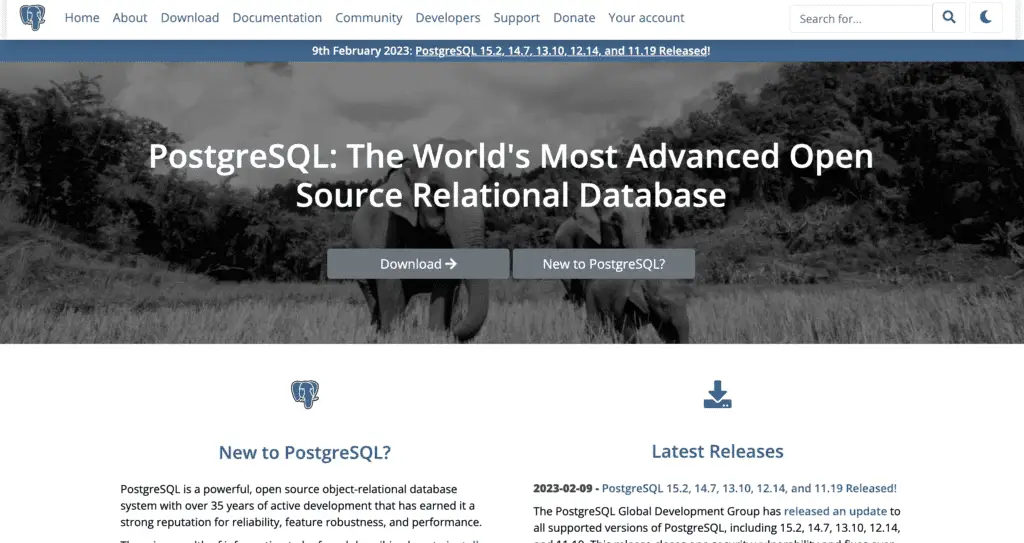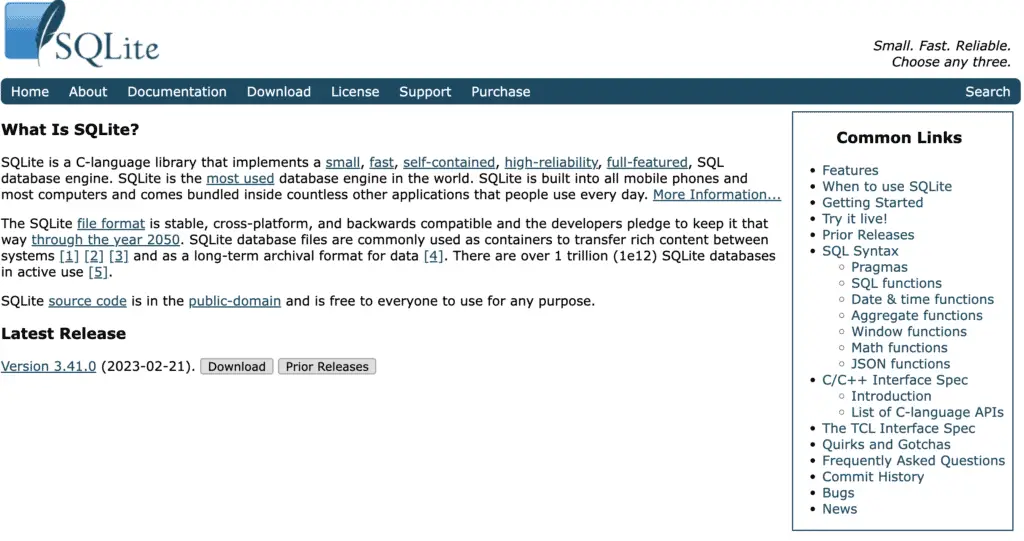This post may contain paid links to my personal recommendations that help to support the site!
Python is a high-level programming language with easy-to-use syntax and a wide array of applications.
It’s no surprise that it has become one of the most popular coding languages today, so it’s important to have the best database for Python that works well with Python.
Let’s have a look at the 5 best databases that work great with Python!
What Are The 5 Best Databases for Python?
Here are 5 best databases for python that work best in 2023:
1. MySQL

Overview:
MySQL is an open-source relational database management system that works well with Python.
Relational databases store data in the form of tables, which can be linked to one another to create relationships between different pieces of data.
A MySQL database is popular for web applications, e-commerce sites, and other large-scale projects.
When using Python to access data from a database, you’ll require a database that has a large selection of Python SQL libraries.
In this case, MySQL has a few to choose from:
- mysqlclient
- mysql-connector-python
- PyMySQL
These connectors allow you to write SQL queries within your Python code. This makes it great for data analytics since data query statements can be embedded in your Python script for cleaning data.
Advantages:
- Easy to use and understand
- Has several packages to access MySQL through Python, such as mysqlclient, mysql-connector-python, and PyMySQL
- Offers high performance, scalability, and reliability
- Has a wide range of features for data storage, backup, recovery, replication, and security
Examples:
MySQL can be used together with Python in several different applications such as:
- Web development
- Data analysis and visualization
- Business Intelligence
My Experience:
When I was working as a data analyst, I worked with MySQL databases to extract relational tables for analysis. The PyMySQL libraries made it extra simple to pull data into Python from the database!
Moreover, I was able to run SQL queries from within Python as well.
Overall, based on my own experience, the MySQL database is the best to use with Python.
2. MongoDB
Overview:

MongoDB is a document-oriented NoSQL database system best suited for storing large amounts of data.
It uses a JSON-like structure called BSON to store information instead of having relational database functionalities, making it easier for developers to work with the data.
Using Python, you can access MongoDB through the pymongo library. This allows your Python code to read and write data from MongoDB.
Advantages:
- Uses a flexible document-based data storage structure for storing data
- High scalability and performance for larger datasets
- Fully integrated with Python through the pymongo library, allowing developers to work with MongoDB without having to learn a new language
Examples:
MongoDB can be used together with Python to store large amounts of information in applications such as:
- Content management systems
- Real-time analytics
- Social media platforms
My Experience:
I had a chance to work on MongoDB databases for a while before I left my first data analyst role. The problem with many NoSQL databases was that they were not simple to denest using Python.
I solved this issue by using MongoDB’s Compass GUI to look into the nested data first before querying using Python and unlisting the specific documents.
Overall, it’s a decent database to use with Python!
3. PostgreSQL

Overview:
PostgreSQL is an open-source object-relational database management system software best suited for web applications and data analytics.
It has a wide variety of features that make it great for working with Python, such as support for procedural languages, triggers, stored procedures, user-defined functions, and views.
This makes it a great choice for use in data science and analytics.
Python developers can access PostgreSQL through the psycopg2 library.
Advantages:
- Supports multiple data types and advanced database operations like joins and transactions
- Has a range of features for security, scalability, concurrency, and reliability
- Easily integrated with Python through the psycopg2 library
Examples:
PostgreSQL can be used together with Python in several different ways, such as:
- Data science and analytics
- Geospatial data analysis
- Business intelligence applications
- Creating database automation tools
My Experience:
PostgreSQL is one of those databases that are flexible and easy to pick up for beginners. I used it during one of my SQL projects I did to build up my portfolio.
While I have never tried out the functionalities of hosting website databases on PostgreSQL, I hope to try that out too!
4. SQLite

Overview:
SQLite is an open-source relational SQL database management system software best known for its simplicity and lightweight.
It is a lightweight and self-contained engine that doesn’t require a server or other complicated setup.
This makes it great for working with small datasets, such as web apps or mobile applications.
Python users typically use SQLite with Jupyter Notebooks because of its seamless integration. The best Python SQL library to use for this is SQLite3.
You can even write a SQL query from within your Python code block!
Advantages:
- Lightweight and self-contained, requiring no complicated setup or server installation
- Fast and reliable performance with small datasets
- Easy to use with Python through the sqlite3 library
Examples:
An SQLite database can be used together with Python in several different applications, such as:
- Exploratory data analysis
- Creating web applications
Since SQLite databases are lightweight, they might be the best for working with small datasets, such as web apps or mobile applications.
My Experience:
SQLite was the first database I worked on with Python for my personal projects.
I would recommend this database for beginners or anyone trying it out for the first time due to its simplicity and ease of use.
The sqlite3 library also made querying in SQL within Python Jupyter Notebooks much easier and streamlined.
5. Redis
Overview:
Redis is an open-source in-memory data structure store used commonly with Python.
It’s best suited for caching, messaging queues, and other applications requiring real-time data access.
It stores the data in a key-value pair format and supports various data types, such as strings, hashes, lists, and sets.
Redis is typically used with Python through a redis-py library
This allows you to quickly and easily store and retrieve data from Redis using Python.
Advantages:
- High speed and performance due to its in-memory storage structure
- Compatibility with different types of data, such as strings, hashes, lists, and sets
- Integrated with Python through the redis-py library
Examples:
Redis can be used together with Python in a variety of applications, such as:
- Caching data from web requests
- Storing user sessions in web applications
- Creating message queues for job processing tasks
Related Questions
Which DB is best for Python?
MySQL is the best for Python. It is an open-source, reliable, and robust database management system used in many applications.
It offers a range of features for scalability, reliability, and security.
Additionally, it can be easily integrated with Python through connector libraries.
Which databases support Python?
Popular databases that support Python include MySQL, PostgreSQL, MongoDB, Redis, and SQLite. You can access these databases through their respective Python SQL libraries.
Additionally, many other database systems have drivers or modules that allow you to use them with Python.
Is MySQL good for Python?
MySQL is good for Python. It is an open-source, reliable, and robust database management system in many applications.
Is Python good with SQL?
Yes, Python and SQL are compatible. Python can be used to access a variety of databases such as MySQL, PostgreSQL, MongoDB, Redis, and SQLite through their respective Python SQL libraries.
Additionally, many other database systems have drivers or modules that allow you to use them with Python.
Is SQL or pandas better?
SQL is the best option when working with tabular data as it allows you to store and manipulate data in a structured format.
Pandas is best suited for working with large datasets and complex operations such as merging or joining data from multiple sources.
Ultimately, the best choice depends on your specific use case.
Which database is the best for Python web development?
The best database for Python web development is PostgreSQL. It is an open-source, object-relational database system that offers scalability, reliability, and robust security features. Additionally, it can be easily integrated with Python through the Psycopg2 library.
Which database is the best for Python machine learning?
The best database for Python machine learning is MySQL. MySQL has many SQL libraries to embed into Python code. This allows the database to be integrated well with common machine-learning libraries in Python.
Which database is the best for Python with Flask?
The best database for Python with Flask is SQLite. It is a lightweight, serverless database that can be easily integrated into web applications built with the Flask framework. Additionally, it offers good performance when compared to other databases.
Can Neo4j be used with Python?
Yes, Neo4j can be used with Python. It is a NoSQL graph database with a graph database library, Py2Neo, that allows users to access and manipulate Neo4j databases from a Python application.
Final Thoughts
Python can be used with a variety of different databases. The best database for Python will depend on the specific requirements and use cases.
Popular options include MySQL, PostgreSQL, MongoDB, Redis, and SQLite. Each of these databases offers advantages such as scalability, reliability, performance, and easy integration with Python.
Ultimately, the best choice of a database for Python will depend on the specific application requirements. Make sure to research each option to determine which is best for your use case.
I hope this article has helped you research your Python database!

